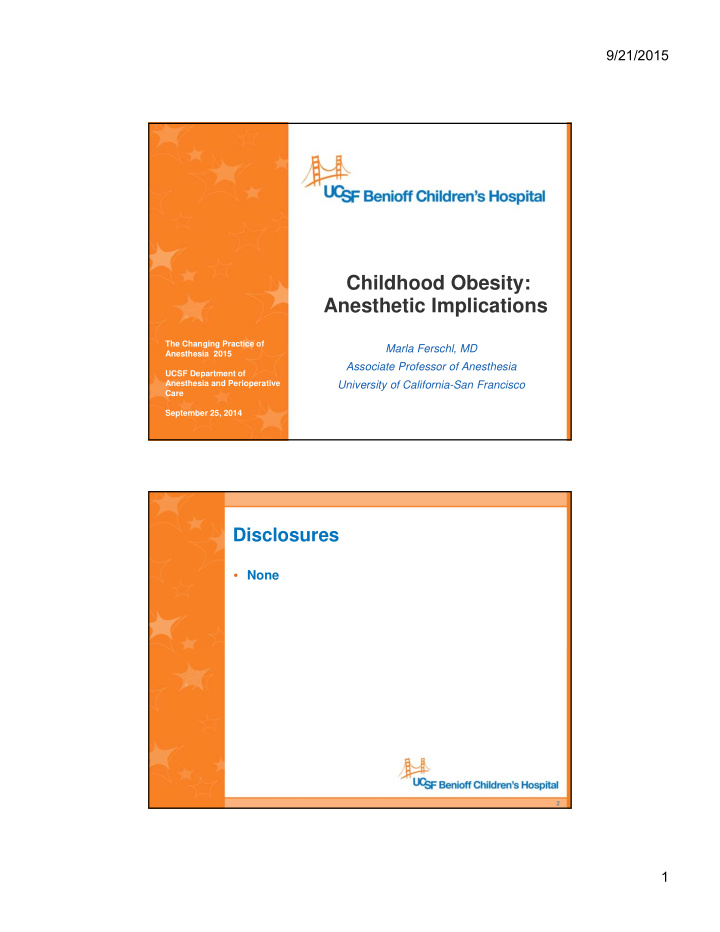



9/21/2015 Childhood Obesity: Anesthetic Implications The Changing Practice of Marla Ferschl, MD Anesthesia 2015 Associate Professor of Anesthesia UCSF Department of Anesthesia and Perioperative University of California-San Francisco Care September 25, 2014 Disclosures • None 2 1
9/21/2015 Overview • Definition • Pathophysiology • Comorbid Conditions • Anesthetic Implications 3 Case Scenario • 6 year old male weighing 55kg presents for adenotonsillectomy in the setting of OSA How do you: 1. Manage his airway 2. Dose Medications 3. Ensure a safe yet rapid emergence 4. Provide adequate post-operative pain control 4 2
9/21/2015 Obesity-Definition • You know it when you see it! 5 Obesity-Definition • Adults: 6 3
9/21/2015 7 Obesity-Definition • Childhood BMI >85%ile=overweight >95%ile=obese Rough estimate: BMI>20 in age 2-5 BMI>25 in age 6-12 8 4
9/21/2015 Obesity Prevalence 9 Health, United States, 2004. U.S. Department of Health and Human Services. 10 5
9/21/2015 Ogden et al. JAMA 2014 11 12 6
9/21/2015 Obesity-Pathophysiology • 90% from excess calorie consumption • 10% secondary to endocrine disorders, neurological conditions, and syndromes 13 Co-Morbid Conditions • OSA – 13-59% of overweight children – Diagnosed by parent hx or sleep study • Mild • Moderate • Severe – Diminished ventilatory response to CO 2 14 7
9/21/2015 Co-Morbid Conditions • Pulmonary – Decreased FRC, FEV1 and DLCO – Asthma • 30% of obese 8-18 year-olds have asthma • Higher BMI correlates with higher severity – More frequent URIs Lang JE et al. J Asthma 2009. Jedrychowski et al. Public Health 1998. Li AM et al. Arch Dis Child 2003. 15 Co-Morbid Conditions • Cardiovascular – 20-30% incidence of HTN – Obese children have increased blood volume and stroke volume increased cardiac output – LVH, hypercholesterolemia and hyperlipidemia 16 8
9/21/2015 Co-Morbid Conditions • Type 2 Diabetes – Metabolic syndrome common – 24% progress to DM within 2 years – 45% of pediatric patients with Diabetes are Type 2!!! Gidding SS et al. J Pediatr 2004 Craig ME et al. Pediart Diabetes 2009 17 Anesthetic Implications Increased relative risk of: • Difficult mask ventilation • Airway obstruction • Desaturation • Bronchospasm 18 9
9/21/2015 Anesthetic Implications 19 Airway Management • More difficult mask ventilation – Oral airway and LMA ready • Meticulous patient positioning – Ramp • Back-up plan if conventional DL fails 20 10
9/21/2015 Pharmacology • How do you know how much to give? • Total Body Weight >> • Lean Body Weight – =IBW +0.3 x (TBW-IBW) >> • Ideal Body Weight – =50% BMI x height (meters 2 ) 21 Pharmacology Approximate Ideal Body Weight by Age Age (yr) Weight (Kg) 1 10 3 15 5 20 7 25 10 30 22 11
9/21/2015 Pharmacology • Theoretically: – Lipophilic drugs have increase volume of distribution – Hydrophilic drugs remain unchanged 23 Recommended Dosing Algorithm Medication Dosing Weight Thiopental sodium Lean body weight (more rapid awakening) Lean body weight (induction bolus) Propofol Total (actual) body weight (maintenance infusion) Etomidate Lean body weight Succinylcholine Total (actual) body weight Pancuronium Ideal body weight Rocuronium Ideal body weight Vecuronium Ideal body weight Cisatracurium Ideal body weight Fentanyl Lean body weight Alfentanil Lean body weight Remifentanil Lean body weight Total (actual) body weight (bolus dose) Midazolam Ideal body weight (infusion) Paracetamol Lean body weight Neostigmine Total (actual) body weight Total (actual) body weight or ideal body Sugammadex weight + 40% Enoxaparin (VTE prophylaxis) Total (actual) body weight 0.5 mg·kg − 1 24 12
9/21/2015 Pharmacology • General rule – Initial dosing to ideal body weight; titrate to effect • Succinylcholine dosed to Total Body weight • Highly lipophilic drugs (midazolam, thiopental) may stick around longer • Caution with opioids as ventilatory response to CO 2 may be altered 25 Emergence and Recovery • Patients more prone to airway obstruction, awake extubation • Caution with opioids in recovery room and for home • When in doubt, admit 26 13
9/21/2015 Case Discussion • 6 year old male weighing 55kg presents for adenotonsillectomy in the setting of OSA – IV induction unless experienced in inhalational induction – Dose propofol to LBW, muscle relaxants to ideal body weight – Consider Desflurane – Minimize opioids until patient spontaneously ventilating, then titrate to effect – Consider dexmedetomidine to smooth emergence (0.5 g-1 g/kg) – Awake extubation – Careful post-op observation 27 Questions? 28 14
9/21/2015 15
Recommend
More recommend